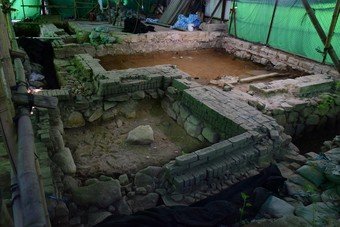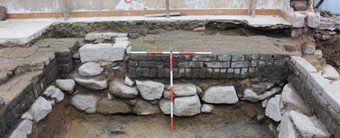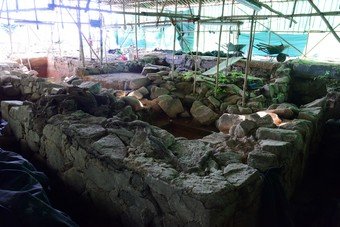


Progress of archaeological excavation works of Nga Tsin Wai Village Project
The Urban Renewal Authority (URA) announced today (7 June) the preliminary findings of the Archaeological Impact Assessment (AIA) of the Nga Tsin Wai Village Project (The Project) as well as the works in progress. This includes a further archaeological investigation and excavation based on the recommendations made by the independent archaeological expert for a holistic assessment of the site’s overall heritage value.
At the media briefing held today, URA’s Executive Director (Commercial), Mr Michael Ma, presents the preliminary findings of the AIA and recaps on the project background. As early as 2006, the URA commissioned a conservation expert of the United Nations Educational, Scientific and Cultural Organization (UNESCO), Mr Laurence Loh, to conduct an initial heritage study of the Project. In 2007, the URA commenced the project incorporating a "Conservation by Design" concept. A conservation park was proposed to preserve three key relics of the village - namely the village gatehouse, the embedded stone tablet and the Tin Hau Temple – as well as the central axis and eight remaining village structures along the axis. This would help preserve the ambience of the old village.
The Government announced the resumption of remaining unacquired land titles of the Project site in 2011. In 2012, the URA, based on the initial heritage study by Mr Laurence Loh and in accordance with the requirements of the Antiquities and Monuments Office (AMO), commissioned an independent archaeological expert, Ms Julie Van Den Bergh, to conduct an independent AIA. After the completion of acquisition, rehousing and compensation work of the Project in 2016, archeological excavation works commenced between March and October of the same year. The AIA aimed to discover the historical relics below the ground surface, including possible watchtowers and village walls, village moat and evidences of dwellings and cultural periods of early settlement, by way of trench excavations. The key preliminary findings of AIA in 2016 indicated that the stone foundations of the village wall and watchtower were present in various degrees of preserved conditions at the northeast and southwest corners of the village. The earliest constructions could be dated back to the Ming and Qing dynasties.
Mr Michael Ma adds that the preliminary findings of the AIA in 2016 provided information of the village during the Ming and Qing dynasties. An initial report of the 2016 AIA was submitted to the AMO in December of the same year. After a thorough examination of the preliminary findings of the AIA, the URA suggested to carry out further excavation by the archaeological expert, with a view to conduct more comprehensive assessment of the site’s overall heritage value before making any recommendation on preservation measures. AMO granted the URA the new excavation permit and the expanded excavation work has started early this year with an area of about 390 square metres, which is four times the licensed excavation area in 2016.
The AIA work is still in progress, and it is the URA’s plan to submit the AIA report to the AMO at the end of the year. Mr Michael Ma said, “Since the AIA work is still in progress, the URA has not concluded the preservation plan yet, and no development will be commenced until the completion of the preservation plan and Government’s consent obtained.”
(ENDS)
